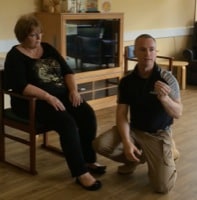In addition to the issues we have previously identified [ Post 1 ] and [ Post 2 ] in regards to those residents who combatively resist efforts to assist them with personal hygiene (particularly if they have incontinence without awareness of this), one further example of the risk assessment/manual handling issue is that I often hear that a care home has a resident who requires cleaning when they are in bed AND they are resistant to that essential care.
My recommendation has always been that cleaning or caring for a mobile person in a bed who is actively resisting those efforts (IF it becomes absolutely necessary to do so) will require perhaps as many as 5 staff to accomplish it using physical holding.
The procedure we might suggest to staff for this kind of scenario could require 4 staff to safely hold the subject which then allows 1 staff member to safely carry out the personal hygiene care. In our opinion, with a mobile person who can move their limbs freely, this is the minimum requirement to carry out the task with the maximum of safety, minimum disruption time and the appropriate level of professionalism.
One major consideration here is that a team of 5 staff with a good plan can complete the cleaning task in less time with more safety and comfort for the person than a team of 2 staff can with less control and less safety. A team of 5 staff can get ‘back on the floor’ faster by far than the struggling team of 2 AND leave the client less distressed, more comfortable and safer.
Staff often resist the idea that this task might need so many people, however if we ask the question: what is in the resident’s best interests? then I think the answer would be: “To be subjected to any intrusive procedure for the minimum amount of time possible”
From both of these perspectives (staff time-on-task and resident time-in-discomfort) then it must be considered how the staff team will achieve their task of cleaning the resistant resident where other non-physical options have been exhausted.
—————————————–
Gerard O’Dea is a conflict management, personal safety and physical interventions training consultant. He is the training director for Dynamis, a specialist provider of personal safety and violence management programmes and the European Adviser for ‘Verbal Defense and Influence’, a global programme which addresses the spectrum of human conflict. www.dynamis.training



